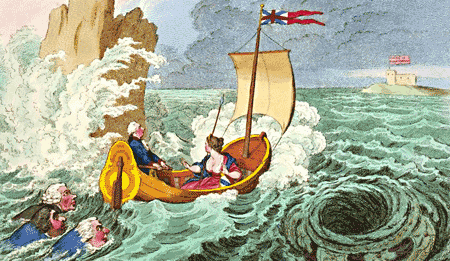Charybdis of Greek Mythology
Charybdis (Greek mythology) is one of several Greek monsters that appeared in multiple famous myths, such as "The Odyssey" and "Jason and the Argonauts". She is often known only in her most vicious form - a swirling whirlpool of death that swallowed enormous amounts of water and anything that got caught in it.
She wasn't always this way. Originally she was a naiad, a water nymph, and the goddess of the tide. She was the beautiful and immortal daughter of the sea god Poseidon (Greek mythology) and the earth goddess Gaia (Greek mythology). In this form, she served her father as something of a conqueror in his quest for dominance of sea over land. Poseidon would create storms on the sea which his daughter would ride onto the land, flooding and inundating towns, forests, and beaches alike.
 A later British voyage between Scylla and Charybdis
A later British voyage between Scylla and CharybdisShe was so successful that the king of the gods, Zeus, took notice of her claims on his land and grew furious. He transformed her into a sea monster, a giant bulbous beast with a giant mouth, and chained her to the bottom of the sea in the Strait of Messina. Three times a day her sea monster form would suck down water from the sea and spit it back out, forever continuing her duties of creating the tides, but swallowing anything that got caught in her whirlpool.
Charybdis famously sits directly across the Strait of Messina from another sea monster, Scylla. Together they make travel through the Strait a nightmare decision - be eaten by Scylla or swallowed by the whirlpool.
In The Odyssey, the hero Odysseus chooses to sail closer to Scylla and lose a few of his men rather than risk his entire ship swallowed up in the inescapable whirlpool. The Argonauts, with help from Hera (Greek mythology) were able to avoid both sea monsters altogether.
